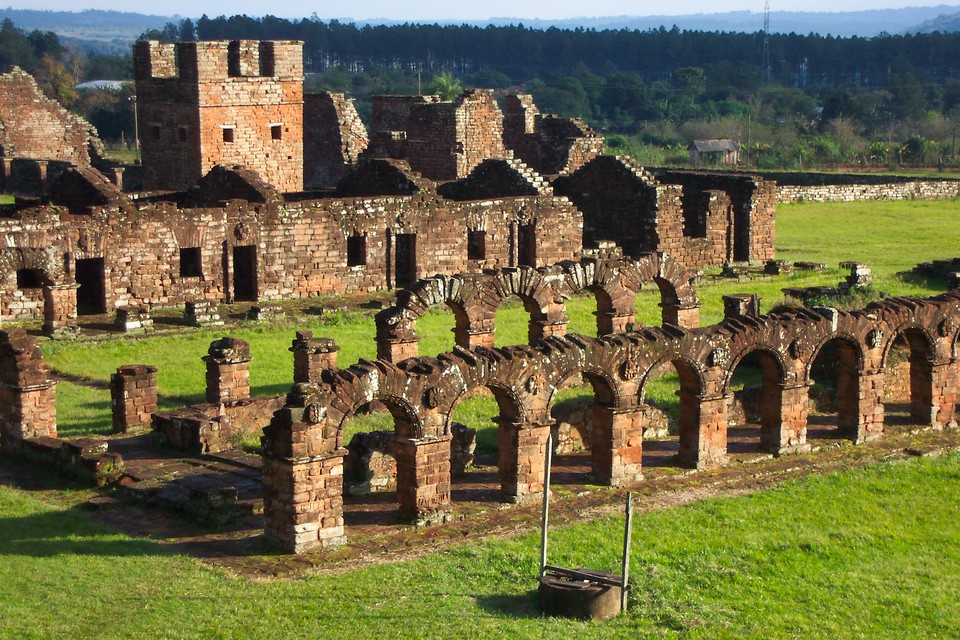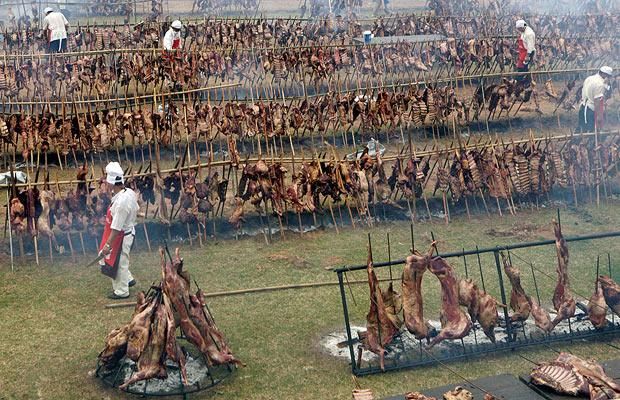When I
went to Brazil in 2003, I spent my first week in Curitiba, which is the state capital
of Paraná. I was asked many times whether I was going to travel to visit Foz de
Iguaçu and see the famous waterfalls. However, it was on the other side of the
state, and it just wasn’t feasible to fit into my schedule or budget. But if I ever
make the trip back to Brazil, I definitely want to add this into the trip.
While the city is on the border with Paraguay, the actual falls are across the
border from Argentina. Foz de Iguaçu (or Foz de Iguazu in Spanish) is pretty much a five-and-a-half-hour
straight shot to Asuncion, Paraguay. I’ve already got this planned out.
Kind of like
certain dishes, everyone has their own take on how the name Paraguay came to be. Many historians and
linguists have come up with a variety of translations over the years, but most
of them stem from the Guaraní language and most have something to do with water
or the river.
Paraguay is a
landlocked country in the central part of South America. The northern part
borders with Bolivia (the other landlocked country in South America), part of
the eastern section borders with Brazil, and the southern and western parts touch
Argentina. Its climate is tropical and subtropical, depending on where you
are. The Paraguay River, which is
the second-longest river in South America, pretty much divides the country in
two.
The first people
moved into this area thousands of years ago. Today, there are still 17
different ethnolinguistic groups still living in Paraguay. The first Europeans
to arrive in the area were the Spanish when de Espinosa’s crew created what
would become the capital city of Asunción. Jesuit missions popped up across
Paraguay as well as other areas throughout South America with the mission of forcing
Christianity among the indigenous peoples who were content praying to whatever
they prayed to. Paraguay actually kicked the Spanish out in 1811. It only took
three years to get their first dictator, José Gaspar Rodríguez de Francia, who
wanted to set the country up as a utopian society and pushed a mixed-race
(mestizo) society among other things. Although there wasn’t a lot of slavery in
Paraguay, it was officially banned in 1844. In 1864, Paraguay entered the
Paraguyan War against the Triple Alliance of Brazil, Uruguay, and Argentina. It
was one of the bloodiest wars in Latin American history, although the actual
causes are still being debated. The first half of the 20th century
saw numerous back-to-back coups and presidential changes. In 1954, Alfredo
Stroessner took to power, and his Colorado Party had a history of violating
human rights and violence to get things done until he was overthrown in 1989. The
Colorado Party that had been in power for the past 60 years finally lost its
majority. However, Fernando Lugo, who won by a landslide, was impeached in 2012
on grounds of a badly executed land eviction among other issues.
Asunción, otherwise
known as Nuestro Señora Santa María de la Asunción, is the capital city of
Paraguay. As one of the oldest cities in South America, founded in 1537, it was
named after the Catholic Feast of the Assumption (held August 15). Today, the
city has over 2.1 million people in its metro area. It sits on the banks of the
Paraguay River, which pretty much borders with Argentina, especially heading
south of the city. Not only is it the center of government, but it’s also a
center of commerce, banking, and education. It’s rife with museums, historical
buildings, sports facilities, theatres, and arts galleries.
For much of the
past 40-50 years, Paraguay has had one of the highest economic growth patterns
in South America, and it only continues to grow. They are among the world’s
leading producers of stevia, soybeans, corn, tung oil, wheat, and beef.
They're also known for their yerba mate production. Agriculture is extremely important since most of the country lives in rural
areas. Mining, pharmaceutical, and manufacturing industries have really began
setting footholds in the country. Even at that, the country still struggles
with wage inequality; estimates show between 35-50% of the country lives in
poverty, and most of those in the rural areas. Clean drinking water and
electricity haven’t even made it to the vast majority of the rural and
indigenous population.
Nearly 90% of
Paraguayans are Roman Catholic. There are smaller numbers of various Protestant
denominations as well as some communities of other religions such as Baha’i,
Islam, and indigenous religions.
Officially,
Paraguay is bilingual in both Spanish and Guaraní. The Guaraní language is one
of the largest indigenous languages in South America, native to Paraguay and
Bolivia (although there are also communities in Argentina and Brazil as well).
The city of Asunción has many speakers of a dialect called Jopará, which is
more of a casual form of Guaraní that uses quite a bit of Spanish loan words.
Because of its history and proximity to Brazil, there are also a significant
number of Portuguese speakers.
From what I’ve
gathered in reading about Paraguay and its people, they’re society is built
around the land, their food, and hospitality. They even made it into the
Guinness Book of World Records for having the world’s largest barbecue that
hosted nearly 30,000 people. It’s easily a country I could spend some time in,
eating my way from city to city.
Up next: art and
literature








No comments:
Post a Comment